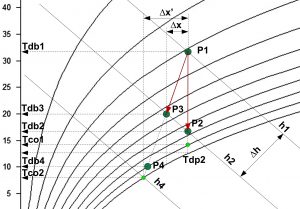There are two ways to cool the air:
• Surface cooling – the air is in contact with a cooler surface
• Wet adiabatic cooling – evaporating water removes heat from the air – the link is here
Surface cooling
When cooling the air using the cooling register, two situations can occur:
1) The surface temperature of the register is above the dew point temperature of the cooled air (dry cooling surface, Tco > Tdp),
If the temperature of the cooling surface Tco1 is higher than the dew point temperature Tdp2 of the cooled air, no water is precipitated on the surface of the register. The absolute content of water vapor x in the air does not change, the relative humidity increases. The state change in the h-x diagram thus takes place parallel to the lines of constant absolute humidity x downwards (ie P1 – P2). Depending on the size of the cooling capacity, the air cools more or less, but does not reach the surface temperature of the Tco1 register, because only a part of the air comes into direct contact with the cooling fins (the so-called bypass effect).
2) The surface temperature of the register is below the dew point temperature of the cooled air (wet cooling surface, Tco< Tdp),
If the temperature of the cooling surface Tco is below the dew point temperature Tdp of the cooled air, part of this air is cooled to such an extent that water vapor condenses on the surface of the register. The state of the air behind the register can therefore be imagined as a mixture of cooled dehumidified, only cooled and practically uncooled air. (Bypass effect). For simplified calculations, the state change in the h-x diagram is represented by a line running from the initial state of the air Tdb1 to the intersection of the mean temperature of the cooling surface Tco2 with the saturation curve (i.e. P1 – P3 – P4). The resulting air is in state P2, which lies between the initial state P3 and the mean temperature of the cooling surface Tco (according to the size of the cooling capacity), the air never reaches the temperature of the cooling surface (bypass effect). Even with a low cooling capacity, the air is not only cooled, but also dehumidified. At the same time, the absolute humidity x decreases and the relative humidity RH increases.
In order to cool 1 kg of air from the temperature Tdb1 to the temperature Tdb2, we must remove heat from it:
Δh = h1 – h2 [kJ / kg]
The mean temperature of the cooling surface Tco1 depends on the design of the cooling register and is generally about 1… 2 °K above the mean value of the flow and return temperatures.
The required cooling capacity is based on:
Qco = m * Δh [kW]
Amount of cooling water:
mw = Qco / cw / ΔTw [kg / s]
As the examples in graph below – more condensing is consumed for condensed cooling than dry cooling. The difference is the dissipated heat generated by the condensation of water:
Δq = R ∗ Δx [kJ / kg]
In condensed cooling, the state change actually takes place not along lines, but along a more or less curved line Tdb1 / Tco2. The curvature is due, among other things, to the hydraulic connection.

